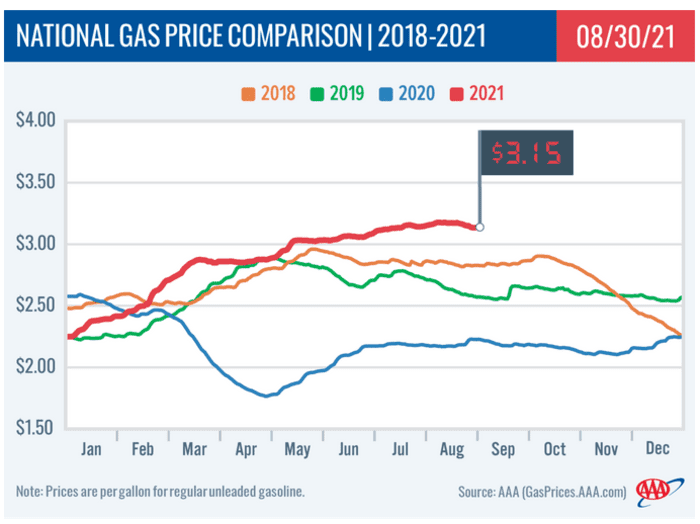Labor Day weekend traditionally signals the conclusion of the U.S.’s summer driving season, but it may not mark the end of the peak period for gasoline prices, currently near their highest since 2014.
The Atlantic storm Ida, which hit the U.S. Gulf Coast as a Category 4 hurricane on Aug. 29, led to the shutdown of some key Gulf Coast refinery operations, and it’s still not clear when those may fully resume.
On Wednesday, Entergy Corp.
ETR,
which provides power for states including Louisiana and Mississippi, said it would take time to fully restore power given significant damage across the region. The Wall Street Journal reported it could take weeks to resume refinery operations due to widespread power outages.
The disruption comes at a time of increased travel, and as gasoline consumption continues to recover from the effects of COVID restrictions on the economy.
Gasoline demand has been strong over this summer, at just 3.5% below 2019 levels, said Ken Robinson, market research manager at workforce management and reimbursement platform Motus. Travel volume data suggest that people “remain more comfortable driving than flying,” he said.
U.S. motor gasoline supplied, a proxy for demand, was at 9.5 million barrels per day on average over the four weeks ended Aug. 27, up from 8.9 million barrels per day the same period a year earlier, according to the Energy Information Administration. For roughly the same period in 2019, implied demand was at 9.7 million barrels per day.
Gasoline may still have room to rise as Robinson said he expects Ida, which affected offshore wells, ports, refineries and pipelines, to “drive gas prices to their 2021 peak.” He estimates a potential, but temporary, five- to nine-cent increase in prices due to the storm that would likely ease off by early October “at the latest.”

AAA
Retail gasoline prices have already inched higher following the storm, with the average national price at $3.183 a gallon on Thursday, up from the week-earlier average of $3.146, according to AAA. Reformulated gasoline futures
RBV21,
haven’t climbed over the past seven days but, at $2.11 on Wednesday, had gained nearly 76% from 52 weeks ago.
Read: Biden takes aim at OPEC and gasoline prices — here’s why analysts are skeptical
Patrick De Haan, head of petroleum analysis at travel and navigation app GasBuddy, predicts an even larger price impact from the storm. Ida may lead to a five- to 15-cent per gallon rise in retail gasoline prices, he said, and a rise at the top end of that range would mark a new peak for prices this year. The worst-case scenario would be several weeks of power outages at refineries that lead to a retail gasoline-price spike of more than 15 cents, he says.
Either way, the potential for more disruptions remains, since Atlantic hurricane season remains far from over. The season officially ends on Nov. 30, and the National Hurricane Center shows three more weather systems brewing in the Atlantic basin.
Gasoline demand traditionally slows down after Labor Day, and prices for the fuel typically start to decline, noted Andrew Gross, a spokesman for AAA. With the increasing COVID case numbers, AAA, he said, would expect prices to decrease.
However, the hurricane season stands as an important “caveat that could spike gas prices,” he said. The impact of a significant storm like Ida could be “felt for weeks in terms of regional spikes in gas prices due to demand, infrastructure damage, and transportation issues,” said Gross.
With prices so close to the year’s high, it wouldn’t take much to reach a new peak. In early August, gasoline prices reached $3.19 a gallon, the highest level in seven years, according to Gross.
It’s likely that while gasoline prices may ease in the post-Ida period, they will probably remain above $3 a gallon through early fall, he said.

